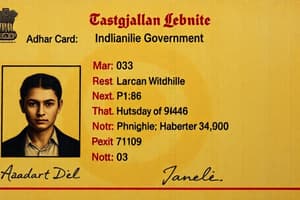Podcast
Questions and Answers
Who proposed the Continental Drift theory?
Who proposed the Continental Drift theory?
Alfred Wegener
What is the name of the mega ocean that surrounded the supercontinent Pangaea?
What is the name of the mega ocean that surrounded the supercontinent Pangaea?
Panthalassa
What was the first wave of homo sapiens migration to India known as?
What was the first wave of homo sapiens migration to India known as?
- Tibeto-Burmese migration
- Aryan migrations
- Out of Africa migrants (correct)
- Harappa migration
Did the Harappa migration occur between 7000 BCE and 3500 BCE?
Did the Harappa migration occur between 7000 BCE and 3500 BCE?
The Indian subcontinent is inhabited from the south to the lower ____________ range in the north.
The Indian subcontinent is inhabited from the south to the lower ____________ range in the north.
What are the official languages of India?
What are the official languages of India?
What is the capital of India?
What is the capital of India?
Which of the following is NOT a national emblem of India?
Which of the following is NOT a national emblem of India?
What is the significance of the term 'Meluha'?
What is the significance of the term 'Meluha'?
What day is celebrated as India's Independence Day?
What day is celebrated as India's Independence Day?
Match the following names with their correspondences:
Match the following names with their correspondences:
Flashcards are hidden until you start studying
Study Notes
Who Are We Indians?
- Indians are diverse peoples, inhabiting the subcontinent from the southern regions to the lower Himalayan range in the north.
- Various names used include Indians (from Indus), Hindustani (from Hindustan), and Bharati (from Bharat).
- No specific tracing of genealogy origins; origins traced back to the Indus Valley Civilization.
Migration and Anthropology
- Four significant migrations shaped the modern Indian population:
- Out of Africa migration: First Homo sapiens arrived 65,000 years ago.
- Harappa migration: Agriculturalists migrated from Iran between 7000 BCE and 3500 BCE, contributing to the Harappan civilization.
- Aryan migrations: Pastoralists from Central Asian Steppes migrated between 2000 BCE and 1000 BCE.
- Tibeto-Burmese and Austro-Asiatic migration: Occurred around 4000 years ago from East Asia.
India’s Geographical and National Identity
- Pre-1947, India encompassed the entire Indian subcontinent, including present-day Bangladesh and Pakistan.
- Modern geographical India includes northern, southern, western, and Himalayan regions.
- Neighboring countries include China, Nepal, Bangladesh, Sri Lanka, Pakistan, Myanmar, Bhutan, Maldives, and part of Afghanistan (J&K).
National Identity
- India is the seventh-largest country in area and has the largest population globally.
- Officially known as "the Republic of India" with New Delhi as its capital.
- Comprises 28 states and 8 union territories.
- Official languages are Hindi and English; Independence Day celebrated on August 15.
- The President serves as the head of the country.
National Symbols
- Apex judicial authority: Supreme Court.
- National flag: Tricolor.
- National emblem: Lion of Sarnath.
- National anthem: "Jana Gana Mana."
- National song: "Vande Mataram."
- Recognized national days:
- Republic Day on January 26.
- Independence Day on August 15.
- Gandhi Jayanti on October 2.
- National symbols:
- Animal: Tiger.
- Flower: Lotus.
- Bird: Peacock.
- Tree: Banyan.
- Calendar: Saka Calendar.
Historical Context of India’s Name Evolution
- Meluha: Refers to the flourishing Indus Valley Civilization, destroyed by climatic events and calamities.
- Bharatavarsha: Named after Emperor Bharata, signifies ancient India as land of people from the Bharata clan.
- Sindhu: An ancient kingdom along the Indus River banks, located near southern Punjab and parts of Pakistan.
- Hindustan: Derived from Persian word for Hindu/Sindhu; reflects the region's heritage.
- India: The modern name derives from the Indus River, linking back to ancient civilizations.
Studying That Suits You
Use AI to generate personalized quizzes and flashcards to suit your learning preferences.




